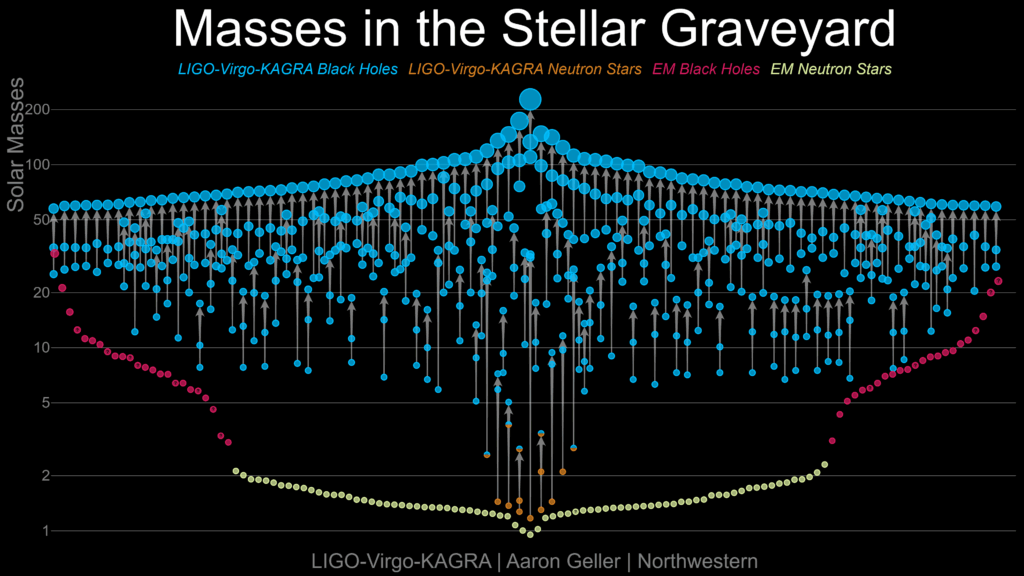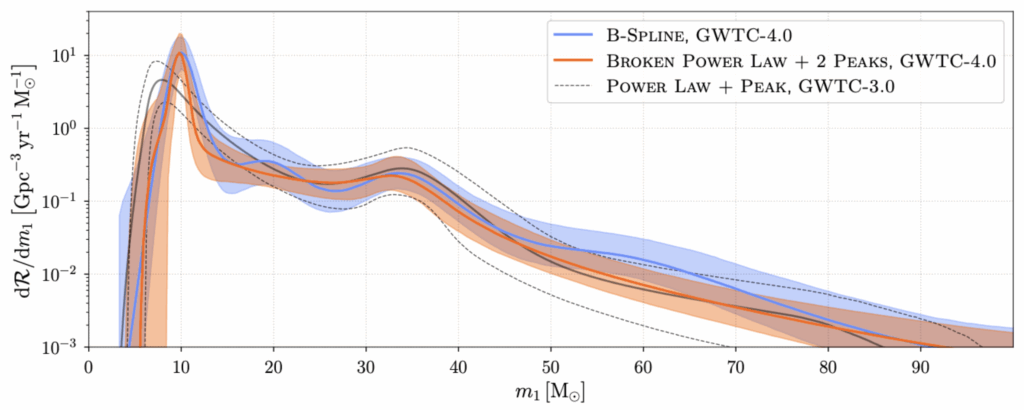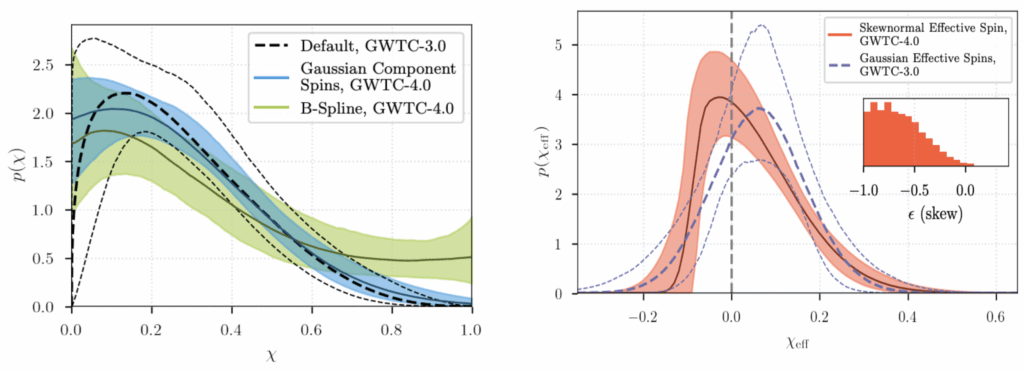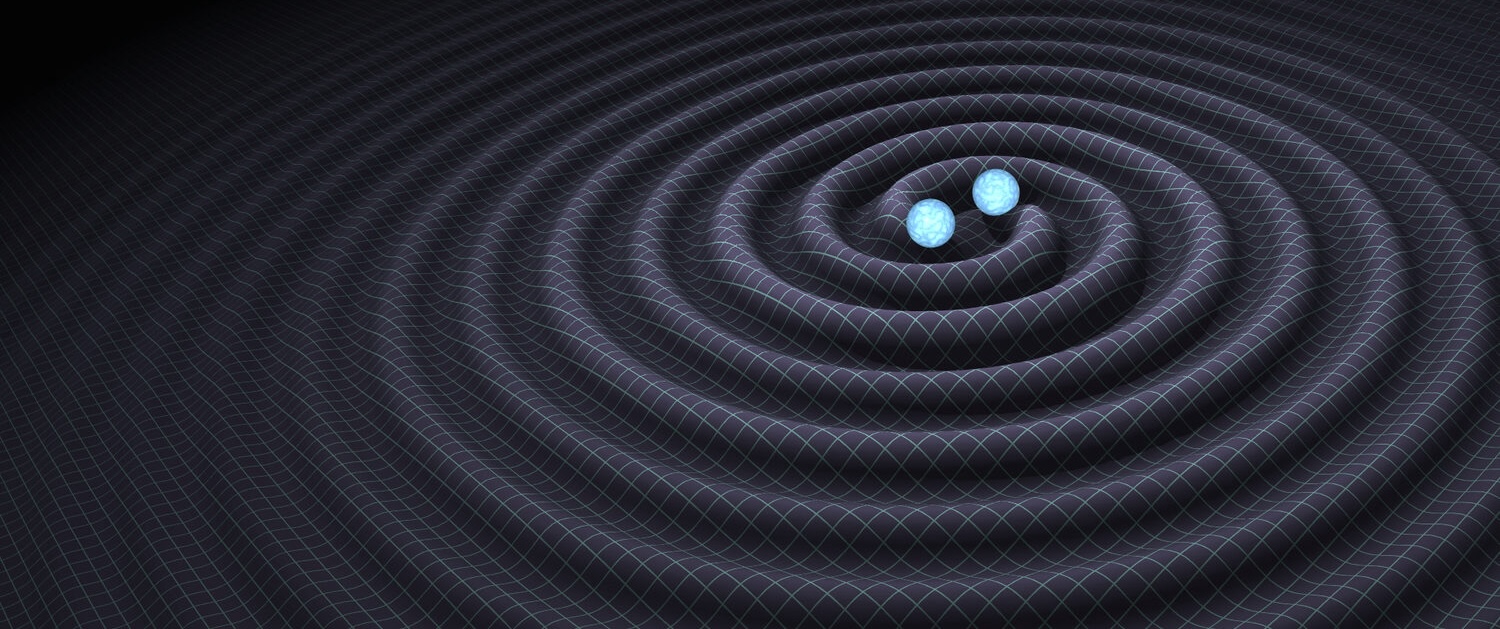
Figure 1: Gravitational-wave observations of black holes (blue) and neutron stars (orange) from the LIGO–Virgo–KAGRA GWTC-4.0 catalog are shown alongside electromagnetic observations of black holes (red) and neutron stars (yellow). The plot highlights the wide range of compact object masses, the overlap between black holes and neutron stars, and the emerging structure in the so-called “lower mass gap” between them. Question-marked electromagnetic observations denote unconfirmed candidates and/or highly uncertain mass constraints. [Image credit: LIGO-Virgo-KAGRA/Aaron Geller/Northwestern]
Our Universe harbors stars with a wide variety of masses. While most stars have masses similar to that of the Sun, we know that some can have masses tens to hundreds times larger. The compact remnants, like neutron stars and black holes, which these massive stars can leave behind as their end-points can also exhibit a similarly wide range of masses. To uncover how the astrophysical ancestors of these objects form, evolve, and die, we can gain insight by studying the gravitational waves (GWs) emitted from the mergers of binary systems containing such compact objects, detected by the ground-based laser interferometers operated by the LIGO, Virgo and KAGRA (LVK) collaborations. However, it is generally more informative to study the entire population than to focus on any single compact binary merger. In this summary, we describe the population properties of 161 compact binary mergers in GWTC-4.0 – the largest such GW catalog published to date.
Compact binaries are thought to form through two broad formation channels. The first one, called “isolated binary evolution”, involves a pair of massive stars that have minimal to no interaction with any other objects during their lifetime. These massive stars collapse to leave behind black holes or neutron stars. The other channel, called “dynamical formation” involves formation of a binary when multiple objects interact with each other in a dense stellar environment such as globular clusters.
Methods
The compact binary mergers presented in this work span binary neutron stars (BNS), neutron star–black hole pairs (NSBH), and binary black holes (BBH). Our paper paints a portrait of how these systems form and merge across cosmic time. They are drawn from the newly-published GWTC-4.0 catalog of GW detections, and include events from the first part of the LVK’s fourth science observing run (O4a) which began in May 2023 and ended in January 2024. The events were identified adopting a false-alarm rate (FAR) threshold of < 1 yr⁻¹ for BBHs (yielding 84 new O4a BBHs, for a cumulative total of 153 BBHs detected to date) and a stricter FAR < 0.25 yr⁻¹ for NS-containing systems (retaining only GW230529 among new O4a NSBH candidates) to ensure minimal contamination from noise masquerading as real signals.
Inferring population properties requires correcting for what we term “selection effects”—a common issue in many areas of observational astronomy: our GW detectors are more sensitive to nearby, higher-mass mergers than to distant, lower-mass ones, and we need to take this into account in our analysis. GW signals from compact binaries are precisely predicted by general relativity and, unlike light, GWs are only weakly affected by intervening matter. This allows us to estimate our GW selection effects accurately and precisely. We injected millions of synthetic GW signals—spanning plausible mass, spin, and redshift distributions—into real data streams and measured the detection efficiency of multiple search pipelines, i.e. the fraction of these synthetic signals that were successfully detected. Hence, these injections can be used to calculate the selection function, which helps us to correct for our selection effects and enables unbiased inference of the mass, spin, and redshift distributions of the actual population of sources that are present in the universe, and not just the populations that we observe. We also validated and cross-checked our results using multiple models, each with its own trade-offs between accuracy and precision.
Results
A number of features identified in the GWTC-3.0 version of the analysis persist. Specifically, there is an excess of objects between 1–2 M⊙ (here and later, M⊙ refers to the mass of the sun) very likely signifying neutron stars in binary neutron star systems as well as black hole–neutron star systems. As we can see in Figure 2, the black-hole mass distribution (i.e. the relative proportion of black holes of different masses) is anything but smooth—it can be described using a double power law, shallow at low masses and steep at high masses, with overdensities near 10 M⊙ and 35 M⊙. There is also evidence of an overdensity near 20 M⊙. Black holes in the 35 M⊙ peak are more likely to pair with companions of similar masses when compared to black holes across the rest of the mass spectrum.

Figure 2: Primary black hole mass spectrum, i.e. the distribution of masses of the larger-mass black hole (the ‘primary’) in our detected binary systems. GWTC-4.0 (blue/orange) refines the earlier GWTC-3.0 Power Law + Peak (black dashed), with clearer support for structure around ~10 M⊙ and ~35 M⊙.
Black holes are defined not only by their mass but also by their spin, which is a measure of how rapidly (and in what direction and alignment with respect to the binary orbit) they are rotating. These spins (independently or in conjunction with their masses) can carry signatures of their birth environment, formation and evolutionary history. Observed black-hole spins hint at the presence of multiple formation channels. Figure 3 shows the black-hole spin distribution inferred for GWTC-4.0. While the distribution is broad, 90% of black holes have spin magnitudes that are less than 0.57 times the maximum allowed according to general relativity. The distribution of the effective spins shown in Figure 4 is asymmetric about zero, and is skewed towards positive values. Specifically, 20–40% of black holes have negative effective spins, which are thought to be only produced in the dynamical formation channel.

Figure 3 (left panel): Distribution of individual black hole spin magnitudes (χ), where χ is a dimensionless number expressed as a fraction of the maximum value allowed by general relativity . GWTC-4.0 models (blue and green) suggest lower average spins and broader shapes than the default GWTC-3.0 result (black dashed).
Figure 4 (right panel): Distribution of effective spin (χeff). GWTC-4.0 (red) prefers a skewed distribution, while GWTC-3.0 (blue dashed) assumes a symmetric Gaussian. Inset shows the inferred distribution of the skew parameter ε.
In GWTC-3.0, we reported evidence that unequal-mass systems have a higher mean effective spin than equal-mass systems. In this work, we confirm a correlation between mass ratio (i.e. the secondary mass divided by the primary mass) and effective spin, though it remains unclear whether this reflects a shift in the mean or a change in the spread of the spin distribution. We also find that black holes outside the 30–40 M⊙ range favor an asymmetric spin distribution skewed toward larger values, while those within this range show no such tendency. These qualitatively distinct trends may point to different underlying physical mechanisms driving spin–mass correlations in binary black holes.
Based on our GWTC-4.0 analysis, we can update the inferred local Universe merger rates for compact binary coalescences to be 8–250 Gpc⁻³ yr⁻¹ for BNS, 9–84 Gpc⁻³ yr⁻¹ for NSBH, and 14–26 Gpc⁻³ yr⁻¹ for BBH. While the upper limit on the BNS merger rate has decreased, the uncertainty on the BBH merger rate estimates has narrowed to roughly half the previous uncertainty from GWTC-3.0. We also find that there are more BBH mergers per unit volume at larger redshifts as compared to the local Universe, and we can rule out a merger rate that decreases or does not evolve with redshift.
Conclusions
The larger dataset in GWTC-4.0 as compared to GWTC-3.0 has permitted the discovery of new features in our data, while strengthening the significance of previously known features. With the rest of the fourth observing run as well as the upcoming fifth observing run promising a much larger catalog of compact binaries, we stand poised to further sharpen these features, fill in the gaps, and trace the full life stories of compact binaries. We expect these results to play a key role in uncovering the processes that govern the formation and evolution of compact binaries, informing our broader understanding of astrophysical processes across cosmic time.
Find out more:
- Visit our websites:
- Read a free preprint of the full scientific article here or on arxiv.
- Additional papers presenting GWTC-4.0:
- Gravitational-Wave Open Science Centre data release for GWTC-4.0 available here.
Back to the overview of science summaries.

